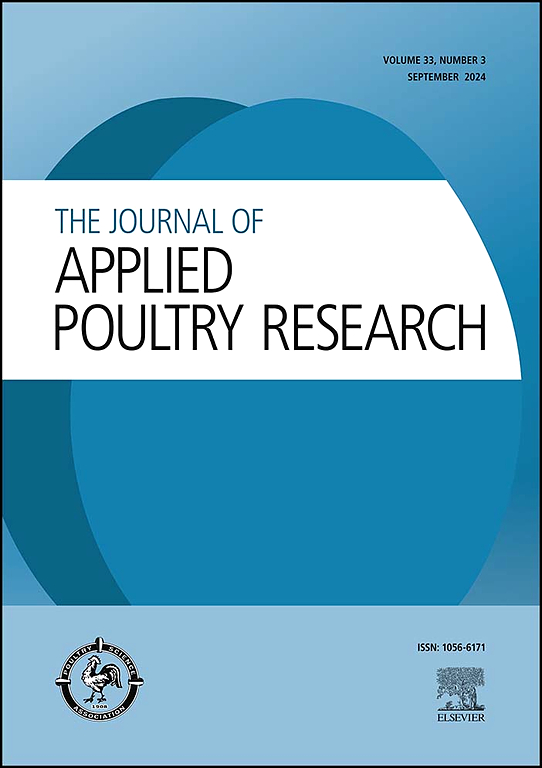Enogen®玉米在标准日粮和能量缺乏日粮中替代常规玉米的评价
IF 2
3区 农林科学
Q2 AGRICULTURE, DAIRY & ANIMAL SCIENCE
引用次数: 0
摘要
本研究评估了在标准饲粮和能量限制饲粮中用Enogen®玉米替代传统玉米对雏鸡生长性能、体成分、骨骼健康和主要发育阶段肠道形态的影响。饲喂常规玉米或Enogen®玉米(内源性表达耐热α-淀粉酶)为基础的饲粮,分别减少或不减少200 kcal/kg能量。本研究的目的是评估这些饮食改变是否,如果是,如何影响雏鸡在关键生长阶段的生理适应和能量分配。在限能饲粮条件下,雏鸡表现出通过增加采食量来维持体重和生长速度的代偿性摄食行为。在自由采食条件下,Enogen®玉米替代对生长性能没有显著改善;然而,观察到饲料效率提高的数值趋势。身体组成,包括脂肪和肌肉百分比,在所有饮食中保持稳定,表明有效的代谢稳态。骨矿化和微结构不受饮食治疗的影响,这表明饮食中矿物质的充足性支持骨骼发育。同样,肠道结构没有形态学变化,表明平衡的蛋白质、氨基酸和矿物质支持肠道完整性,而不需要代偿性重塑。这些结果强调了在基本营养需求得到满足的情况下,雏鸡对适度膳食变化的适应能力。虽然Enogen®玉米在标准喂养方案中的益处尚不确定,但其在能量限制和挑战条件下的潜力值得进一步研究。本文章由计算机程序翻译,如有差异,请以英文原文为准。
Evaluation of Enogen® corn as a replacement for conventional corn in standard and energy-deficient diets for pullets
This study evaluated the effects of substituting conventional corn with Enogen® corn in standard and energy-restricted diets on pullet growth performance, body composition, bone health, and intestinal morphology across major pullet developmental phases. Birds were fed conventional corn or Enogen® corn (expressing thermostable α-amylase enzyme endogenously) based diets, with or without a 200 kcal/kg energy reduction. The aim of this study was to evaluate whether, and if so, how, these dietary modifications influence physiological adaptation and energy partitioning during critical growth phases in pullets. Pullets showed compensatory feeding behavior under energy-restricted diets by increasing feed intake to maintain body weight and growth rates. Enogen® corn substitution did not significantly improve growth performance under ad libitum feeding conditions; however, numerical trend toward improved feed efficiency was observed. Body composition, including fat and muscle percentages, remained stable across all diets, suggesting effective metabolic homeostasis. Bone mineralization and microarchitecture were unaffected by dietary treatments, suggesting the adequacy of dietary minerals in supporting skeletal development. Similarly, intestinal structure showed no morphological changes, indicating that balanced protein, amino acids, and minerals supported gut integrity without necessitating compensatory remodeling. These results emphasize the resilience of pullets to moderate dietary variations when fundamental nutritional requirements are met. While the benefits of Enogen® corn in standard feeding regimens were inconclusive, its potential under energy-restricted and challenge conditions warrants further research.
求助全文
通过发布文献求助,成功后即可免费获取论文全文。
去求助
来源期刊

Journal of Applied Poultry Research
农林科学-奶制品与动物科学
CiteScore
4.10
自引率
10.50%
发文量
80
审稿时长
104 days
期刊介绍:
The Journal of Applied Poultry Research (JAPR) publishes original research reports, field reports, and reviews on breeding, hatching, health and disease, layer management, meat bird processing and products, meat bird management, microbiology, food safety, nutrition, environment, sanitation, welfare, and economics. As of January 2020, JAPR will become an Open Access journal with no subscription charges, meaning authors who publish here can make their research immediately, permanently, and freely accessible worldwide while retaining copyright to their work. Papers submitted for publication after October 1, 2019 will be published as Open Access papers.
The readers of JAPR are in education, extension, industry, and government, including research, teaching, administration, veterinary medicine, management, production, quality assurance, product development, and technical services. Nutritionists, breeder flock supervisors, production managers, microbiologists, laboratory personnel, food safety and sanitation managers, poultry processing managers, feed manufacturers, and egg producers use JAPR to keep up with current applied poultry research.
 求助内容:
求助内容: 应助结果提醒方式:
应助结果提醒方式:


